Firstclass5
On this page, you find all documents, package deals, and flashcards offered by seller FirstClass5.
- 396
- 0
- 32
Community
- Followers
- Following
428 items
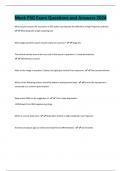
Mock PSG Exam Questions and Answers 2024
What would increase the resolution of EEG spikes and improve the definition of high frequency activity? Recording with a high sampling rate What stage would the epoch shown below be scored as? Stage N1 The cortical activity seen at the very end of the epoch in question 2, is best described as: Spontaneous arousal Refer to the image in question 2 above, the light grey vertical lines represent: One second markers Which of the following actions should be taken to avoid ground loops: Ensur...
- Package deal
- Exam (elaborations)
- • 19 pages •
What would increase the resolution of EEG spikes and improve the definition of high frequency activity? Recording with a high sampling rate What stage would the epoch shown below be scored as? Stage N1 The cortical activity seen at the very end of the epoch in question 2, is best described as: Spontaneous arousal Refer to the image in question 2 above, the light grey vertical lines represent: One second markers Which of the following actions should be taken to avoid ground loops: Ensur...
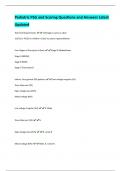
Pediatric PSG and Scoring Questions and Answers Latest Updated
Technical Requirements -Montage is same as adult -EtCO2 or PtCO2 in children <13y/o to assess hypoventilation Four Stages of Scoring for Infants Stage W (Wakefulness Stage N (NREM) Stage R (REM) Stage T (Transitional) Infants: Four general EEG patterns Low voltage irregular (LVI) Trace Alternant (TA) High voltage slow (HVS) Mixed voltage (MV) Low voltage irregular (LVI) R, Wake Trace Alternant (TA) N High voltage slow (HVS) N, rarely R Mixed voltage (MV) Wake, R, rarely N Scorin...
- Package deal
- Exam (elaborations)
- • 4 pages •
Technical Requirements -Montage is same as adult -EtCO2 or PtCO2 in children <13y/o to assess hypoventilation Four Stages of Scoring for Infants Stage W (Wakefulness Stage N (NREM) Stage R (REM) Stage T (Transitional) Infants: Four general EEG patterns Low voltage irregular (LVI) Trace Alternant (TA) High voltage slow (HVS) Mixed voltage (MV) Low voltage irregular (LVI) R, Wake Trace Alternant (TA) N High voltage slow (HVS) N, rarely R Mixed voltage (MV) Wake, R, rarely N Scorin...
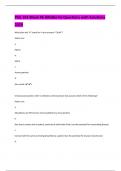
PSG 103 Week #6 (Midterm) Questions with Solutions 2024
What does the "A" stand for in the acronym "CALM"? Select one: a. Apnea b. Alarm c. Assure patients d. Aim nozzle c Universal precautions refer to infection control policies that assume which of the following? Select one: a. All patients are HIV (human immunodeficiency virus) positive b. Any direct contact with a patient, particularly with body fluids, has the potential for transmitting disease c. Contact with the same aire being breathed by a patient has the potential for d...
- Package deal
- Exam (elaborations)
- • 23 pages •
What does the "A" stand for in the acronym "CALM"? Select one: a. Apnea b. Alarm c. Assure patients d. Aim nozzle c Universal precautions refer to infection control policies that assume which of the following? Select one: a. All patients are HIV (human immunodeficiency virus) positive b. Any direct contact with a patient, particularly with body fluids, has the potential for transmitting disease c. Contact with the same aire being breathed by a patient has the potential for d...
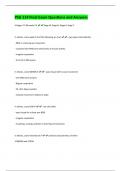
PSG 114 Final Exam Questions and Answers
4 Stages 37-48 weeks CA Stage W, Stage N, Stage R, Stage T In infants, score wake if all of the following are met - eyes open intermittently - REM or scanning eye movement - sustained chin EMG tone with bursts of muscle activity - irregular respiration - LVI or M in EEG waves In infants, score N(REM) if - eyes closed with no eye movement - chin EMG tone present - Regular respiration - TA, HVS, Sleep spindles - reduced movement relative to wake In infants, score REM if - low chin EMG...
- Package deal
- Exam (elaborations)
- • 20 pages •
4 Stages 37-48 weeks CA Stage W, Stage N, Stage R, Stage T In infants, score wake if all of the following are met - eyes open intermittently - REM or scanning eye movement - sustained chin EMG tone with bursts of muscle activity - irregular respiration - LVI or M in EEG waves In infants, score N(REM) if - eyes closed with no eye movement - chin EMG tone present - Regular respiration - TA, HVS, Sleep spindles - reduced movement relative to wake In infants, score REM if - low chin EMG...
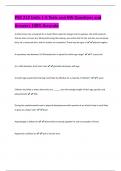
PSG 212 Units 1-5 Tests and HW Questions and Answers 100% Accurate
A child comes into a sleep lab for a study. When asked to change into his pajamas, the child responds that he does not own any. While performing the hookup, you notice that his hair and skin are extremely dirty, he is extremely thin, and his clothes are unwashed. These may be signs of physical neglect A respiratory rate between 24-38 breaths/min is typical for which age range? 0-1 years old As a child develops, their heart rate gradually decreases with age At which age would toilet traini...
- Package deal
- Exam (elaborations)
- • 17 pages •
A child comes into a sleep lab for a study. When asked to change into his pajamas, the child responds that he does not own any. While performing the hookup, you notice that his hair and skin are extremely dirty, he is extremely thin, and his clothes are unwashed. These may be signs of physical neglect A respiratory rate between 24-38 breaths/min is typical for which age range? 0-1 years old As a child develops, their heart rate gradually decreases with age At which age would toilet traini...
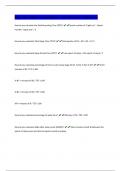
Psg calculations Questions and Answers Rated A+
How to you calculate the Total Recording Time (TRT)? Epoch number of "Lights on" - Epoch number "Lights out" / 2 How do you calculate Total Sleep Time (TST)? Total epochs of N1 + N2 + N3 + R / 2 How do you calculate Sleep Period Time (SPT)? Last epoch of sleep - first epoch of sleep / 2 How do you calculate percentage of time in each sleep stage (% N1, % N2, % N3, % R)? % N1= minutes of N1 / TST x 100 % N2 = minutes of N2 / TST x 100 % N3 = minutes of N3 / TST x 100 %R = minutes of...
- Package deal
- Exam (elaborations)
- • 4 pages •
How to you calculate the Total Recording Time (TRT)? Epoch number of "Lights on" - Epoch number "Lights out" / 2 How do you calculate Total Sleep Time (TST)? Total epochs of N1 + N2 + N3 + R / 2 How do you calculate Sleep Period Time (SPT)? Last epoch of sleep - first epoch of sleep / 2 How do you calculate percentage of time in each sleep stage (% N1, % N2, % N3, % R)? % N1= minutes of N1 / TST x 100 % N2 = minutes of N2 / TST x 100 % N3 = minutes of N3 / TST x 100 %R = minutes of...
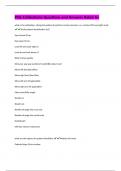
PSG-Calibrations Questions and Answers Rated A+
what is the calibration, asking the patient do perform certain exercises, in a routine PSG overnight study Verify patient identification (x2) Eyes closed 30 sec Eyes open 30 sec Look left and Look right x2 Look up and Look down x2 Blink 5 times quickly Stick your jaw way out/clench teeth/Bite down hard Move left foot (Dorsiflex) Move right foot (Dorsiflex) Move left arm (if applicable) Move right arm (if applicable) Fake snore/Fake cough Breathe in Breath out Breathe through the...
- Package deal
- Exam (elaborations)
- • 3 pages •
what is the calibration, asking the patient do perform certain exercises, in a routine PSG overnight study Verify patient identification (x2) Eyes closed 30 sec Eyes open 30 sec Look left and Look right x2 Look up and Look down x2 Blink 5 times quickly Stick your jaw way out/clench teeth/Bite down hard Move left foot (Dorsiflex) Move right foot (Dorsiflex) Move left arm (if applicable) Move right arm (if applicable) Fake snore/Fake cough Breathe in Breath out Breathe through the...
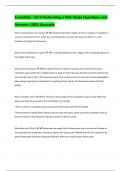
Essentials - Ch 9 Performing a PSG Study Questions and Answers 100% Accurate
What is the frequency of a wave? Characterized by the number of times it repeats or oscillates in a second; measured in Hz or Cycles per second (cps); the narrower the wave, the faster it is, and therefore the higher the frequency What is the amplitude of a wave? It is directly affected by the voltage of the associated signal; it is the height of the wave What is Time Constant? Also called fall time or fall time constant; the amount of time for a calibration wave to fall from its highe...
- Package deal
- Exam (elaborations)
- • 3 pages •
What is the frequency of a wave? Characterized by the number of times it repeats or oscillates in a second; measured in Hz or Cycles per second (cps); the narrower the wave, the faster it is, and therefore the higher the frequency What is the amplitude of a wave? It is directly affected by the voltage of the associated signal; it is the height of the wave What is Time Constant? Also called fall time or fall time constant; the amount of time for a calibration wave to fall from its highe...
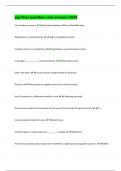
psg final questions and answers 2024
The Ultradian process is the balance between REM and NonREM sleep Wakefulness is characterized by higher sympathetic activity Circadian rhythm is controlled by hypothalamic suprachiasmatic nucleus In teenagers __________ is noted worldwide phase delay sleep Ohm's law states Current equals voltage divided by resistance Polarity is the positive or negative nature of an electrical signal the G1 electrode in a differential amplifier is the exploring electrode During a sleep study the G1 elec...
- Package deal
- Exam (elaborations)
- • 12 pages •
The Ultradian process is the balance between REM and NonREM sleep Wakefulness is characterized by higher sympathetic activity Circadian rhythm is controlled by hypothalamic suprachiasmatic nucleus In teenagers __________ is noted worldwide phase delay sleep Ohm's law states Current equals voltage divided by resistance Polarity is the positive or negative nature of an electrical signal the G1 electrode in a differential amplifier is the exploring electrode During a sleep study the G1 elec...

PSG fundamentals test 1, Questions and Answers 2024
What channel is not typically used in sleep staging? A)EOG B)EMG C)EKG D)EEG C) EKG Sleep serves to reverse repair what lost or damaged in body during prolonged wakefulness? Restorative theory Delta theta alpha bate order wave forms from slowest to highest frequency? (Remember DETAB) True What substance blocks adenosine? Caffeine Not a con from sleep deprivation? Infertility Quite sleep in infants is similar to REM sleep in adults? T or F False How long is a sleep cycle in adults?...
- Package deal
- Exam (elaborations)
- • 6 pages •
What channel is not typically used in sleep staging? A)EOG B)EMG C)EKG D)EEG C) EKG Sleep serves to reverse repair what lost or damaged in body during prolonged wakefulness? Restorative theory Delta theta alpha bate order wave forms from slowest to highest frequency? (Remember DETAB) True What substance blocks adenosine? Caffeine Not a con from sleep deprivation? Infertility Quite sleep in infants is similar to REM sleep in adults? T or F False How long is a sleep cycle in adults?...
